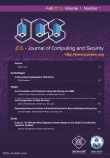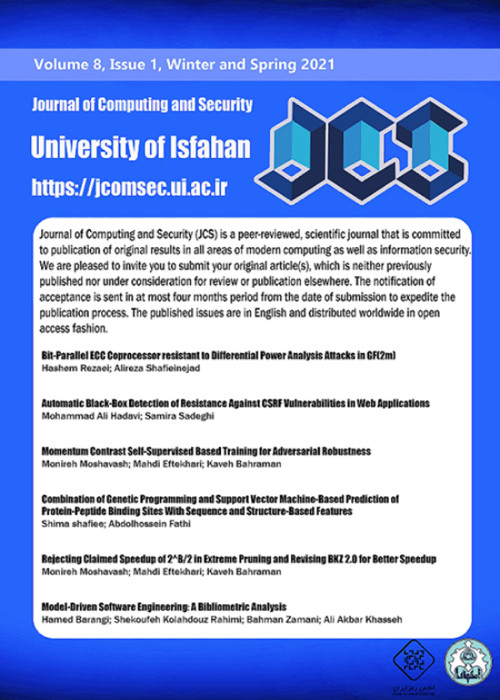فهرست مطالب

Journal of Computing and Security
Volume:2 Issue: 2, Spring 2015
- تاریخ انتشار: 1394/02/15
- تعداد عناوین: 6
-
-
Pages 87-107Adoption of data outsourcing to cloud servers is hindered by data integrity issues due to the lack of trust to the servers. Existing solutions to deal with the problem often require costly verification processes to build a verification object (VO) at the server side and to verify it at the client side, especially when the verification is to be performed at a low-level of granularity. This paper proposes an efficient and privacy-preserving solution, which verifies both the integrity and completeness of query results at the finest level of granularity an individual attribute value. Outsourced data confidentiality is also preserved by securely dividing attribute values into several pieces. As a key novelty, our solution does not require building VOs at the server side for query results. Consequently, 1) no computation overhead is imposed on the server to construct VOs, 2) no change is required to the existing DBMS engines due to calculating VOs and accompanying them with the results, and 3) no information leakage occurs due to building or observing VOs by the server. Our theoretical and empirical analyses indicate the effectiveness of our solution compared to the existing solutions in terms of communication, query execution, and verification overheads.Keywords: Data Outsourcing, Correctness Verification, Verification Object, Multi, Secret Sharing
-
Pages 109-117Cooperative Spectrum Sensing (CSS) is an effective approach to improve the detection performance of vacant frequency bands in Cognitive Radio (CR) networks. The CSS process imposes some security threats to the CR networks. One of these common threats is Primary User Emulation Attack (PUEA). In PUEA, some malicious users try to mimic primary signal characteristics and deceive CR users to prevent them from accessing the vacant frequency bands. The present study introduces a new CSS scheme, in the presence of a malicious PUEA, called Attack-aware CSS (ACSS). The idea is based on the estimation of attack parameters including probabilities of the fake PUEA signals presence in both occupied and unoccupied frequency bands. The obtained parameters are innovatively applied in Neyman-Pearson (N-P) or Log-Likelihood Ratio Test (LLRT) to improve collaborative sensing performance. Simulation results verify the performance improvement of the proposed method against PUEA compared with conventional method.Keywords: Attack Parameters, Cognitive Radio, Spectrum Sensing, Primary User Emulation Attack
-
Pages 119-127Digital audio watermarking is mainly used for ownership protection of digital audio. In this research, an audio watermarking method is presented which can be adopted in real-time situations due to its high speed in both embedding and detecting stages. This approach has a higher payload in comparison with similar recent approaches. In the proposed algorithm, which uses a time-domain synchronization, to embed the watermark, the audio signal is first split into a number of blocks. Then the watermark is embedded into the FFT components of audio signal with greater magnitudes. Unlike common audio watermarking methods that use the 1-bit embedding approach, in the proposed scheme, a 2-bit embedding approach is presented which doubles the embedding payload compared to a number of similar works. The evaluation results on different audio signals demonstrate that the new scheme is faster and more transparent compared to its counterparts. The presented watermarking is found robust enough against the common attacks like additive noise, MP3 compression, low pass filtering, re-sampling and re-quantization. Using FPGA implementation/evaluation, the time complexities of the major parts of the proposed algorithm are reported.Keywords: Real, Time Audio Watermarking, Payload, Robustness, Transparency, Signal Processing Attacks
-
Pages 129-139The modulo 2n ±1 are the most applied modulo set in residue number system (RNS). The modulo adder 2n − 1 is very important due to its variety of applications in DSP, like addition/subtraction and multiplication in digital filters, cryptography, fault detection, fault correction and checksum. In this article, by applying carbon nanotube transistors based on End Around Carry structure, a modulo adder 2n −1 is implemented. The problems are analyzed and in order to fix them and improve the orbital parameters, a new design is proposed. Through this design, the problem for two representations of zero are solved, and by taking advantage of a structure for fast calculation of carry, the orbital parameters are upgraded. The circuits are simulated by Hspice simulation tools and their performances are verified. Simulation results confirm the superior performance of this proposed design compared to the EAC (End Around Carry) structure.Keywords: RNS, Modulo Adder, Nanoelectronic, CNFET
-
Pages 141-153Traditionally, object retrieval methods require a set of images of a specific object for training. In this paper, we propose a new object retrieval method using a single query image, without training, for a global object. The query image could be a typical real image of the object. The object is constructed based on Speeded Up Robust Features (SURF) points acquired from the image. Information of relative positions, scale and orientation between SURF points are calculated and constructed into an object model. The ability to match partially affine transformed object images results from the robustness of SURF points and the flexibility of the model. Occlusion is handled by specifying the probability of a missing SURF point in the model. Experimental results show that this matching technique is robust under partial occlusion and rotation. The obtained results illustrate that the proposed method improves efficiency, speeds up recovery and reduces the storage space.Keywords: Object retrieval, Speeded Up Robust Features (SURF), Training, Free
-
Pages 155-163Today, pervasive systems have become an inseparable part of computer science and engineering. These systems provide automated connection with remote access and seamless transmission of biological and other data upon request. The health domain is one of the most important application of these systems. Moreover, heart is the most important part of human body and cardiac diseases are the second leading cause of death. Therefore, different tools and methods have been invented for the rapid investigation and early detection of cardiac diseases and the cardiac operations. These methods aim to obtain structural and operational information about the heart. Any changes in the form of cardiac signals can indicate a disease or abnormal behavior of the heart. Therefore, early detection of these changes can be significant to prevent and treat cardiac diseases. This paper proposes a method to detect atrial arrhythmia, which is one of the most common cardiac anomalies. The proposed approach can be generalized to detect other arrhythmia disorders. The proposed method models an arrhythmia by a regular expression. After removing the noise and performing the proposed segmentation algorithm, the input signal of the patient is transformed into a character string in which each character represents an ECG signal component. Moreover, a LCS-based tree comparison algorithm is proposed to detect any disorder in the input signal. The proposed algorithm can be used in cell phones or wearable devices. Different experiments on MIT-BIH arrhythmia dataset show the efficiency of the segmentation method and the detection algorithm in comparison to conventional approaches.Keywords: Electrocardiogram, Atrial Fibrillation Arrhythmia, Regular Expression, ECG Segmentation, Longest Common Substring


